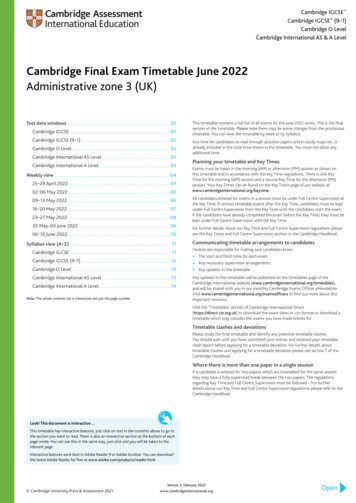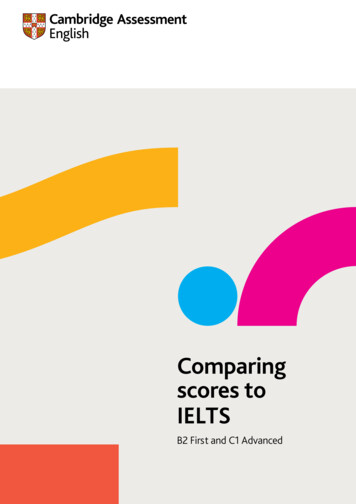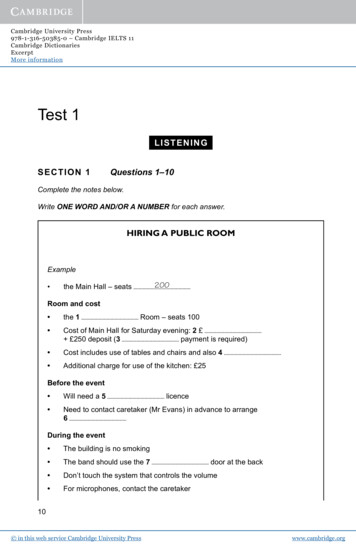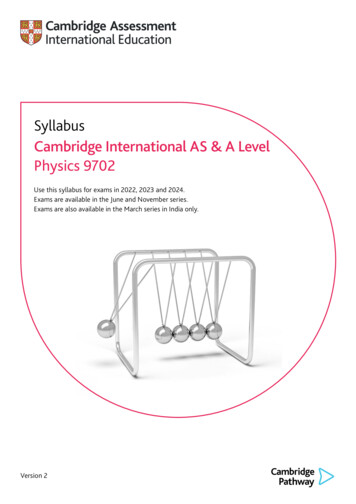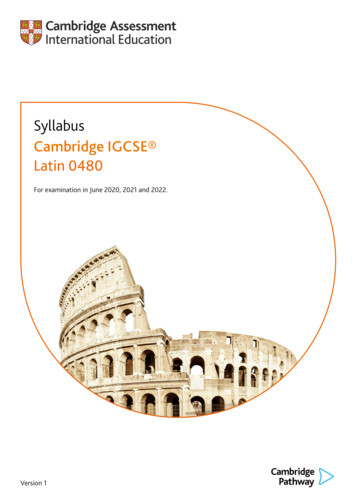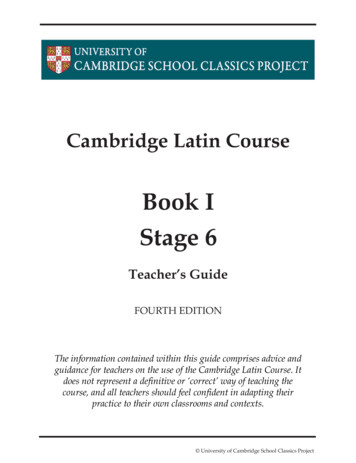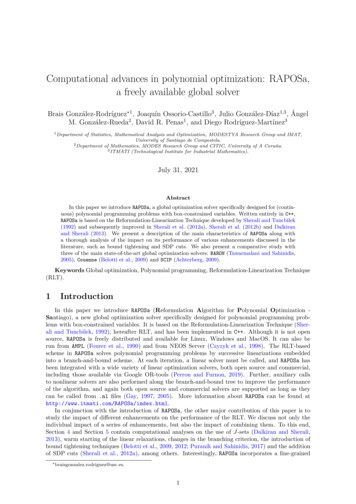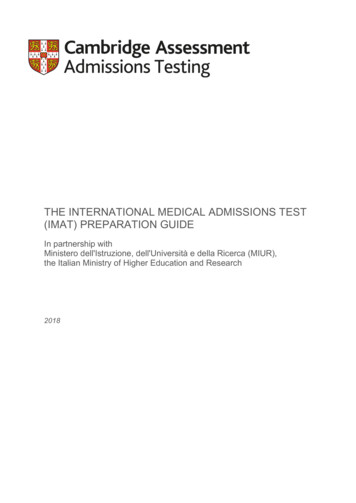
Transcription
THE INTERNATIONAL MEDICAL ADMISSIONS TEST(IMAT) PREPARATION GUIDEIn partnership withMinistero dell'Istruzione, dell'Università e della Ricerca (MIUR),the Italian Ministry of Higher Education and Research2018
Table of ContentsIntroduction . 2The International Medical Admission Test (IMAT).2Purpose of the IMAT guide .2General information and test specification .2Practical advice on how to prepare for IMAT .4Section 1: General Knowledge and Logical Reasoning . 5General Knowledge .5Logical Reasoning .8Problem Solving .81. Relevant Selection . 92. Finding Procedures . 103. Identifying Similarity . 10The mathematical knowledge and skills needed . 11Critical Thinking . 121. Summarising the Main Conclusion . 132. Drawing a Conclusion . 143. Identifying an Assumption . 154. Assessing the Impact of Additional Evidence . 165. Detecting Reasoning Errors . 186. Matching Arguments . 197. Applying Principles . 21Section 2: Biology. 22Section 3: Chemistry . 24Section 4: Mathematics and Physics . 28Mathematics . 28Physics . 321 UCLES 2018
IntroductionThe International Medical Admission Test (IMAT)The International Medical Admissions Test (IMAT) is a subject-specific admissions test inEnglish, designed by Cambridge Assessment Admissions Testing for applicants to Medicineand Surgery courses at Italian International Medical Schools.These courses are taught in English, with places open to both home and internationalstudents. Cambridge Assessment Admissions Testing was appointed by the Italian Ministryof Higher Education and Research (MIUR) to specifically develop IMAT in 2011, a testdesigned uniquely for admission to English-taught medical degrees at Italian universities.Cambridge Assessment Admissions Testing (http://www.admissionstestingservice.org) is aglobal leader in the development of university admissions tests with more than 10 years’experience in the field, working with leading universities in the UK and worldwide to developand administer assessments as part of the admissions process. Their evidence-basedassessments are supported by rigorous and on-going research to ensure that they provideuseful and fit-for-purpose information to support university admissions decisions. They arecommitted to ensuring that all our assessments are fair, have sound ethical underpinningand operate according to the highest technical standards.Cambridge Assessment Admissions Testing is part of Cambridge Assessment, a not-forprofit department of the University of Cambridge. Cambridge Assessment is the Universityof Cambridge’s international exams group, designing and delivering assessments to over 8million learners in over 170 countries.In conjunction with Admissions Testing, the Italian Ministry of Higher Education andResearch has a yearly review of IMAT’s design and format. The details of the review arereleased near the test date by Ministerial Decree and are available on MIUR’s website:http://accessoprogrammato.miur.itPurpose of the IMAT guideThis guide sets out to provide candidates with the necessary information to prepare forIMAT, the entrance examination for undergraduate courses to Medicine and Surgerycourses at Italian International Medical Schools. Many examples and detailed explanationsabout each question type in the admission test are available here, enabling candidates tobecome familiar with the style of questions and the format of the test.Using this guide, candidates will be able to feel more confident that they have developed theskills and knowledge needed to achieve the best possible result.This guide is approved by MIUR and it provides the official specification of both the formatand contents of IMAT.General information and test specificationPrevious IMAT papers included a total of 60 multiple-choice questions. All questions hadfive options, of which only one is correct.Candidates have to answer various kinds of questions related to general knowledge, logicalreasoning and several scientific disciplines. In order to be able to correctly identify the rightanswer in each of the sections, students shall:2 UCLES 2018
1. have a solid general knowledge in the literary, philosophical, historical, social,political and institutional spheres;2. develop logical reasoning skills related to all the proposed types; to this end, it isessential to become familiar with the materials in this guide and with the practicematerial for test-takers on Cambridge Assessment Admissions Testing’s website(www.admissionstestingservice.org);3. have a good knowledge of the scientific disciplines required in accordance with theMinisterial Program for secondary schools for Biology, Chemistry, Mathematics andPhysics, as detailed in this guide.IMAT does not require a great amount of extra study as it relies on skills and knowledge thatcandidates should already have. Candidates can familiarise themselves with the test formatby downloading the test specification and past papers from the Cambridge AssessmentAdmissions Testing r-test-takers/imat/preparing-for-imat/The format of the test is 60 multiple-choice questions with five options each. The fiveoptions might initially all seem plausible, but the students will have to choose not only basedon their knowledge on the subject, but above all, using their own logical reasoning skillsapplied to various subjects.The questions are divided according to the following sections:Section 120 questions - Logical Reasoning2 questions - General KnowledgeSection 218 questions - BiologySection 312 questions - ChemistrySection 48 questions - Physics and MathematicsPlease note that the order in which the questions are presented in the test is not the sameas the order in this guide: questions will be randomised for each exam paper, so eachcandidate’s exam will have a different order of questions and answers.Furthermore, although questions have varying degrees of difficulty, they will not bepresented in any particular ascending or descending order of difficulty.A candidate’s total score is calculated using the following formula:1.5-0.40points for each correct answerpoints for each wrong answerpoints for each question not answered.An overall total score (maximum 90 points) will be reported, together with a score on eachsection.Candidates have 100 minutes to complete the test.3 UCLES 2018
Practical advice on how to prepare for IMATIn order to achieve a good result, candidates must be able to answer correctly as manyquestions as possible in the time available. Therefore, time management is crucial:candidates are advised to practice with past papers under timed conditions so as to use thetime effectively and try to avoid dwelling excessively on certain questions.IMAT is designed to give candidates enough time to answer all of the questions if they workefficiently. If it is difficult to make progress with a question, a candidate can move on to adifferent question and then come back to the question later on. Candidates are notrestricted to doing the questions in the order that they appear on the question paper.Sometimes, the best strategy can be to focus on particular types of question depending onindividual strengths and preferences. A useful tip on how to manage the time availableeffectively is to practice spending no more than a minute and a half for each question. Thiswill help optimize the time, so that candidates quickly answer the questions they find easier,and have more time for more challenging questions.It is essential that candidates practice answering multiple choice questions in all thesections, in order to speed up their response skills to the questions. The only way to dealconfidently with IMAT is to practice, as much as possible, answering questions similar tothose that appear in this guide, so as to become familiar with the question format and thetime available to answer. This is particularly applicable to those questions in the LogicalReasoning section where the importance of carefully reading each question beforeanswering and to take into consideration all five options presented cannot be overestimated.For further examples of Logical Reasoning questions, see the preparation materials for theThinking Skills Assessment (TSA) and Bio-Medical Admissions Test (BMAT) on theCambridge Assessment Admissions Testing website.4 UCLES 2018
Section 1: General Knowledge and Logical ReasoningSection 1 will assess general knowledge and the thinking skills (i.e. logical reasoning) thatstudents must possess in order to succeed in a course of study at the highest level. Suchskills are basic to any academic studies, which often require students to solve novelproblems, or consider arguments put forward to justify a conclusion, or to promote or defenda particular point of view.General KnowledgeGeneral Knowledge questions may address a range of cultural topics, including aspects ofliterary, historical, philosophical, social and political culture.These questions are not based on any specific part of school curricula; rather their aim is totest the candidates’ interest and knowledge in a wide variety of fields. Candidates with akeen extra-curricular interest in current events and that regularly keep up to date withnational and international news will be better prepared to answer this type of questions.With general knowledge questions candidates may often know the correct answer, howeverthey may sometimes be unsure and may be tempted to give up and move on to otherquestions.There are actually some useful strategies that can be adopted to maximise your chances tocorrectly identify the right answer, as illustrated by the following examples.EXAMPLE 1:‘Dubliners’ is a collection of short stories written by which author?ABCDEJ. JoyceF. O’BrienI. SvevoF. KafkaJ-P. SartreThe correct answer is A. This is a typical literary-based general knowledge question.In the event that the candidate was not already familiar with the literary work in question, itis still possible to try to respond through a process of logical elimination. It is commonknowledge that Dublin is in Ireland and therefore it can be safely assumed that the author isIrish. Therefore, the authors with surnames indicating other nationalities can beautomatically eliminated, namely answers C, D and E. Now the candidate has narrowed thechoice between A and B and has much better chances of answering correctly. Answer B isa "distractor" because it is a typical Irish surname, but one that does not correspond to theauthor of the work in question. This example illustrates how the student, in case of notknowing immediately the correct answer, can still benefit from a process of elimination usingtheir logical reasoning skills. This approach can lead to correctly responding to a greaternumber of questions.5 UCLES 2018
EXAMPLE 2:Which country was governed by the Taliban’s theocratic regime from 1996 to 2001?ABCDEAfghanistanIranIraqSaudi ArabiaSyriaThe correct answer is A. This is a typical current affairs/recent history based generalknowledge question.This type of question aims to ascertain whether or not students follow recent events and arewell-informed on major national and international affairs in the contemporary world. Thosecandidates who do not actively follow international news and are not keen readers of goodquality newspapers and magazines will clearly be at a disadvantage.EXAMPLE 3:Which of the following city-monument pair is wrong?ABCDEStockholm – Pont du GardRome – Theatre of MarcellusAthens – ErechtheionIstanbul – Hagia SophiaSplit – Diocletian’s PalaceThe correct answer is A. This is an interdisciplinary general knowledge question based ongeographical as well as historical knowledge.This example can also be solved by using logical reasoning skills – and linguistic skills andintuition, in this case – if the candidate does not know the correct answer immediately.A possible logical method to arrive at the solution is to first identify the correct matches byrecognising the linguistic characteristics of the monuments’ names, even if the candidatedoes not know those specific monuments in particular. Therefore, answers B, C and D canbe safely eliminated at the start. Answer E can be misleading and very attractive becausethe candidate might not know where Split is (i.e. Croatia) or because he/she might not knowthat this geographical area was heavily settled by Romans, hence the name “Diocletian”.However, the correct resolution of the question hinges on the recognition that "Pont duGard" is a typical French name and, therefore, it is not an extremely likely name for amonument in Stockholm, capital of Sweden.The application of logic skills and linguistic abilities is often successful in solvinginterdisciplinary general knowledge questions.6 UCLES 2018
EXAMPLE 4:The World Heritage Convention, adopted by UNESCO in 1972, aims to identify andmaintain a list of sites that may be considered:ABCDEof exceptional cultural or natural importanceof outstanding economic valueto be characterized by a lasting peaceto be conventionally suitable for human settlementto have exploitable energy resourcesThe correct answer is A. This is an example of a question based on culture and politics. Inthis case, the question is about the nature of a world organisation.Even if the candidate does not have direct knowledge of this topic, the candidate should beable to immediately disassociate the term “heritage” with any answer relating to economyand finance, thus eliminating immediately answers B and E. By the same logic ofelimination, C can be de discarded because peace does not relate to “heritage” in any way,leaving only two plausible options and increasing the chances of answering correctly.Overall, general knowledge questions can cover topics ranging from authors and books tofamous personalities, current affairs, history or inventions, world geography and much more.The aim is to test the students’ knowledge of the wider world and their ability to apply logicalreasoning in different contexts. The best way to prepare for such questions is to readwidely, across a range of different subjects and maintain an awareness of current affairs.7 UCLES 2018
Logical ReasoningThe aim of the questions in this section is to evaluate candidates’ reasoning skills andanalytic skills, especially the ability to follow the logical steps in different contexts, torecognise fallacies in the argument, to solve problems and to discern relevant fromirrelevant information.More specifically, there are two types of logical reasoning questions: Problem Solving: questions that involve reasoning using numerical and spatial skills. Critical thinking: questions that involve reasoning using everyday written language.Questions focus on the skills involved in understanding and evaluating arguments.In order to successfully answer these questions, candidates must employ a logicalapproach. No previous knowledge of any particular subject is necessary. Candidates arestrongly encouraged to familiarize themselves with the different types of questions byreading through this guide.Problem SolvingProblem Solving involves reasoning using numerical and spatial skills. The actual numericaland mathematical reasoning required for these questions is quite simple (certainly not atthe same level as required for the mathematics questions in Section 4).There are three kinds of problem solving questions:1. Relevant Selection2. Finding Procedures3. Identifying SimilarityAlthough most questions fall into one category, some questions can fit into more than one ofthe categories. The examples following below show the different types of problem solvingquestions present in IMAT.Selecting relevant informationOften a real-world problem will be overloaded with information, much of which isunimportant. The first step in solving the problem is to decide which bits of the informationavailable are important. It may be that the question has presented you with informationwhich is not important, perhaps redundant and possibly distracting. This kind of questiondemands relevant selection, in which the task is to select only that information which isnecessary and helpful in finding a solution and then applying it.Recognising analogous casesIn each of these questions you will be presented with information and asked to identify thesame information presented in a different way, or the question will present a situation inwhich different information has a similar structure. Many of these questions can involvespatial reasoning ability.Applying appropriate proceduresSometimes you will find that even when you have selected all of the relevant information, noobvious solution presents itself. You then have to find a method or procedure which you canuse to generate a solution from the information in the question. Typically you will have threeor four numbers which have to be operated on in some way, or you will need to perform anoperation a number of times.8 UCLES 2018
1. Relevant SelectionVery often a real world problem will be overloaded with information, much of which isunimportant. This kind of question demands Relevant Selection, in which the task is toselect only that information which is necessary and helpful in finding a solution.The table below shows the price of various ladders. I need a ladder at least 8 m longto reach the gutters of my house. I want to store it in my garage which is only 4.2 mlong.Length closedLength(m)Extended (m)Triple section ladders:2.66.03.07.53.59.04.010.0Double section weight(Home use)Heavyweight(Trade use) 82 104 133-- 100 120 150 169 52 67 78 98--- 64 82 95 115 140 155What is the lowest price I must pay to satisfy these conditions?ABCDE 78 98 133 150 169The answer is C. We need to find a ladder which extends to 8 metres but has a closed lengthof no more than 4.2 metres. There are no double section ladders which fit the requirements.Two triple section ladders are possible, one extending to 9 m and the other to 10 m. Withheavyweight and lightweight options taken into account there are three possibilities. Werequire the cheapest and this costs 133.00. A lightweight ladder with a closed length of 3.5 mand an extended length of 9 m.A 78 - lightweight - too short when extendedB 98 - lightweight - too long when closedD 150 - heavyweight - more expensive than CE 169 - heavyweight - more expensive than C9 UCLES 2018
2. Finding ProceduresSometimes you will find that even if you have selected all of the relevant information, nosolution presents itself. You then have to find a method or procedure which you can use togenerate a solution. Typically you will have three or four numbers which have to beoperated on. This aspect of Problem Solving is called Finding Procedures.Three thermometers are each accurate to within 2 degrees above or below thetemperature they actually read. One reads 7 , one reads 9 and one reads 10 .What is the minimum range in which the true temperature lies?ABCDE5 – 12 7 – 9 8 – 10 8 – 9 7 – 10 The answer is D. The method here is to search for the acceptable highest and lowesttemperatures for the conditions to be met, realising that the middle value is irrelevant. Asone reads 7 , the temperature cannot be above 9 and, as another reads 10 , thetemperature cannot be below 8 . This is given by D.A This is obtained by subtracting 2 from the lowest and adding 2 to the highest.B Takes the lowest reading and goes to 2 above it.C Takes the highest reading and goes to 2 below it.E Takes the range to be from the lowest reading to the highest reading.3. Identifying SimilarityIn this type of question you will be presented with information and asked to identify thesame information presented in a different way, or a situation in which different informationhas a similar structure.I wish to tile an area of wall 120 cm wide by 100 cm high. Tiles are 20 cm square. Iwill, therefore, need 6 x 5 30 tiles.Which of the following uses the same method of calculation as that above?A A staircase is 3 m high. Each step rises 0.25 m. Therefore, there are 12 steps.B A room is 4.2 m by 2.0 m. Carpet costs 10.00 per square metre. Therefore, itwill cost 84.00 to carpet the room.C A box containing sugar cubes is 10 cm x 10 cm x 5 cm. A sugar cube is 1 cm oneach side. Therefore, the box contains 500 cubes.D Using square tables 1.5 m on each side, I need to make up a conference tablethat is 6 m x 3 m. Therefore I will need 8 tables.E I work 40 hours a week and earn 5.00 an hour. Therefore, in 4 weeks I will earn 800.00.The answer is D. The procedure of multiplying 6 x 5 is based on 6 tiles fitting along one edgeand 5 tiles along another. In option D, 4 of the small tables will fit along the 6 m side and 2along the 3 m side. The computation will therefore be 4 x 2.Option A divides 3 by 0.25.Option B multiplies 4.2 by 2.0 by 10.Option C multiplies 10 by 10 by 5.Option E multiplies 5 by 40.Although in D there is a multiplication, this is the only case in which the numbers to bemultiplied must first be obtained as they are in the tiling example.10 UCLES 2018
The mathematical knowledge and skills neededNumber concepts simple fractionsplace value (for example, knowing that the "5" in "7654" indicates "50")ideas about percentages (for example, the idea that 1% could be thought of as "1 inevery 100", and that if 20% of a group of adults are men, 80% must be women).Numerical operations the four rules of number (addition, subtraction, multiplication, division)percentage operations (for example, if something was sold at 10, and is nowadvertised at "20% off", how much would the customer pay?)calculations in everyday contexts (complex calculations with fractions and decimals arenot required).Quantities time and the calendarmoneymeasures as shown below:LengthKilometre (km)Metre (m)Centimetre (cm)Millimetre (mm)WeightKilogram (kg)Gram (g)AreaCentimetre square(cm2)Metre square (m2)Knowledge of the following relationships is also required:1 km 1000 m1 m 100 cm1 cm 10 mmVolume (capacity)Cubic centimetre(cm3)Litre (l)Gallon1 kg 1000 gAlso required is knowledge of the terms for measurements which are used informally indaily life (e.g. feet, miles), but numerical relationships for these measures (e.g. 12 inches 1 foot) are not required.Space and spatial reasoning area (including the calculation of the area of a rectangle)perimeter (including calculation)volume (including the calculation of the volume of a box)reflections (in mirrors) and rotations of simple shapestwo-dimensional (2D) representations of three-dimensional (3D) shapes (for example,being able to interpret a "bird's eye view" of a house).GeneralisationRecognition that some operations are generalizable, for example, that converting 24 to 3and 40 to 5 both involve division by 8 (formal algebra is not required).Tables extracting information from tables.11 UCLES 2018
Critical ThinkingCritical Thinking in the context of the IMAT can best be made clear by the followingdefinition: in an argument, reasons are put forward as grounds for a conclusion. Theargument is a good argument provided its conclusion follows from the reasons. That is tosay, if you accept the reasons, you must accept the conclusion.For the purposes of the Critical Thinking element, the reasons given should be accepted asbeing true so that you can focus on the structure of the reasoning. When you are readingthrough the paragraph, it can be useful to identify different elements so that you can see thereasoning and particularly see the reasons that lead you to a conclusion. Identifying thereasons and the main conclusion is an important part of understanding the structure of anargument.Here is an example of a simple argument:Jill promised she would attend the meeting or send a substitute. We know she can't attendthe meeting. So we are expecting a substitute.The structure of this argument is as follows:Reasons: Jill promised she would attend the meeting or send a substitute. We know shecan't attend the meeting.Conclusion: So we are expecting a substitute.In this case, the conclusion appears at the end of the argument, and is introduced by theword "so". Sometimes a conclusion may be introduced by words such as "therefore", "thus","it follows that". However, sometimes a conclusion may not contain any such word.It is also important to note that a conclusion may appear at the beginning of, or in the middleof, an argument, rather than at the end.For example, the above argument could have been written in this way:We know Jill cannot attend the meeting. We are expecting a substitute. She promised shewould attend the meeting or send a substitute.Or in this way:We are expecting a substitute for Jill. We know she cannot attend the meeting, and shepromised she would attend or send a substitute.In both these cases, "We are expecting a substitute (for Jill)" is the conclusion, because it isthe statement which follows from, or is supported by, the rest of the passage.Some arguments may omit a crucial stage in the reasoning - an assumption which must bemade in order for the conclusion to follow. Here is an example:She doesn't stand much of a chance. The polar bear is right behind her.In this argument it is not explicitly stated that polar bears are dangerous, but the conclusionthat "she doesn't stand much of a chance" depends upon the belief that polar bears aredangerous. This belief is taken for granted, or assumed.In summary, the features of arguments are: reason(s) conclusion(s) (which may or may not be introduced by words such as "so", "therefore") assumption(s) i.e. crucial parts of the argument which have not been stated.12 UCLES 2018
Arguments can be much more complex in structure than the examples given so far and theycan be lengthy. But whatever their length and complexity, there are certain skills involved inunderstanding and evaluating arguments. These include: drawing and summarisingconclusions, identifying assumptions and reasoning errors, and assessing the impact ofadditional evidence.In the Critical Thinking category there are 7 different specific types of questions:1.2.3.4.5.6.7.Summarising the main conclusionDrawing a conclusionIdentifying an assumptionAssessing the impact of additional evidenceDetecting reasoning errorsMatching argumentsApplying principles1. Summarising the Main ConclusionIn this type of question you have to judge which one of the statements A to E bestexpresses the main conclusion of the argument. So the first important step is to read thepassage carefully and pick out the sentence which is the conclusion. Remember that theconclusion can appear anywhere within an argument – not necessarily at the end.Remember also that what you are looking for is the statement which follows from, or issupported by, the rest of the passage.It may be helpful to ask yourself: "What is the main message which this passage is trying toget me to accept?" When you think you have answered this question, underline t
For further examples of Logical Reasoning questions, see the preparation materials for the Thinking Skills Assessment (TSA) and BioMedical Admissions Test (BMAT) on the - Cambridge Assessment Admissions Testing website.


